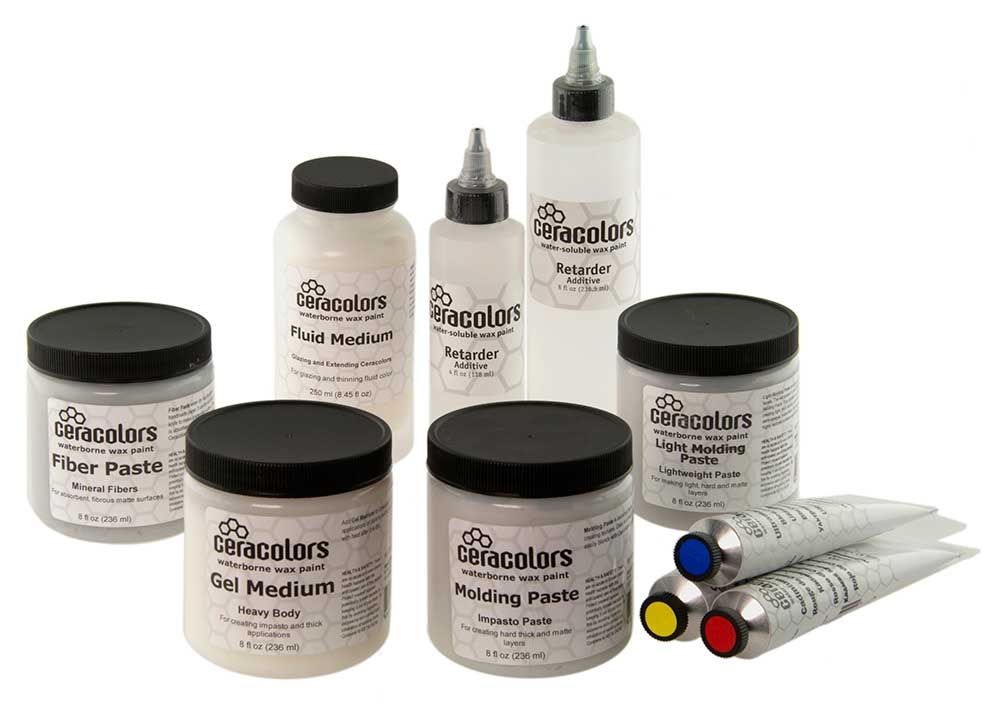
To start painting in Ceracolors colors, you only need paint and water. Ceracolors water-based wax paints handle basically like watercolors or gouache. But for nearly endless possibilities in texture, transparency, viscosity, and sheen, look at the wide world of mediums. Think of Ceracolors mediums like paint without the pigment. They’re made of the same waxy stuff and can be added to any color in any quantity.
What Ceracolors Mediums Can Do For Your Painting
First of all, mediums can be used to extend paint. Since mediums have no pigment, they’re less expensive by volume, so if you’re using one of the more expensive pigments, you can use mediums to get the volume you need while using less paint. Unlike the fillers used in student-grade paint, mediums are made of the same stuff as Ceracolors, so there’s no loss in quality.

There are currently five different mediums available for Ceracolors.
Ceracolors Fluid Medium For Thinning Ceracolors
Ceracolors Fluid Medium is very thin, so I normally put it in a separate container rather than mixed directly with paint. I use Ceracolors Fluid Medium all the time instead of water to make the paint flow and to increase transparency. It tends to level out, leaving few visible brush strokes compared to water. You can see how crisp and clean the medium is. With water, it tends to bleed.
Ceracolors Gel Medium For Transparency and Gloss
Next is Ceracolors Gel Medium Heavy Body. It’s much thicker than Fluid Medium. You can pour it out or use a palette knife. Use it to make the paint flow, increase transparency, and increase gloss. Mixed with paint Ceracolors Gel Medium retains a heavy body, but you won’t get any crisp peaks with this medium. It can be used for glazing thin layers or building up thicker layers. Unlike Ceracolors Fluid Medium, which levels out, Gel Medium retains brushstrokes.
Ceracolors Molding Paste For Impastos
Next is Ceracolors Molding Paste. It’s very waxy and useful for bulking up your paint. Build up big, heavy impastos with a brush or palette knife. You can add a lot of medium before the paint begins to get slightly lighter in appearance. Check out those stalagmites! Ceracolors Molding Paste is thick and sculptural; every mark will dry just as you made it.
Quick note: When using supplies out of a jar or a can, it is best to take an even layer off the top rather than stabbing in the middle, letting in oxygen and drying out the whole container. I learned this the hard way with printmaking ink.
Ceracolors Light Molding Paste For Impastos with Texture
Next is Ceracolors Light Molding Paste which is much fluffier than the Heavy Paste. There is a toothy grittiness due to the presence of ceramic microspheres. It mixes with paint easily and has a workable consistency. This might be my favorite medium. The marks you can make are comparable to the Heavy Molding Paste, but the Heavy Paste appears waxier and the Light Paste more grainy.
Ceracolors Fiber Paste For Extra Body and Texture
Next is Ceracolors Fiber Paste. Also great for adding body and texture, this medium is the grittiest of all. It dries to a matte, paper mache-like texture, and I find it helpful in making a colored ground layer, the first layer of the painting. It is similar to the Light Molding Paste and texture but much heavier and grittier.
Ceracolors Retarder Additive For Slower Drying
Finally, I’ll mention the Ceracolors Retarder Additive, which is not a medium but can be used with any paint and medium combination to slow drying time. Add a few drops to your pile, and you won’t have to worry about it drying out while working.
So here they all are dried and stacked up for comparison.
Remember, you can combine all the different mediums interchangeably. For example, if you liked the handling properties of the Paste Medium but didn’t want a matte finish, brush on a layer of Gel Medium over the top. If you want to bring it to a high gloss finish, polish the dry layer with a microfiber cloth.
If you only have one medium in your kit, I recommend Ceracolors Fluid Medium. Use it instead of water, and you will have a good time. You can experiment with all the other mediums and get your Ceracolors dialed into precisely the look and feel you like.
About The Artist
Alex Rydlinski is a self-taught painter from Fairbanks, Alaska. He spent his twenties living in Texas and traveling the country while writing, performing music, and making illustrations. As his interest in visual art grew, he began learning to paint in oils by studying masterworks in books and museums. In 2017, he studied in Norway with the master painter Odd Nerdrum. Rydlinski continues to be possessed by the aim of joining sincere ideas with sincere craft in everything he creates. In 2019, Rydlinski moved to Alaska’s Kenai Peninsula, which he considers his ideal backdrop for dramatic narrative paintings.












